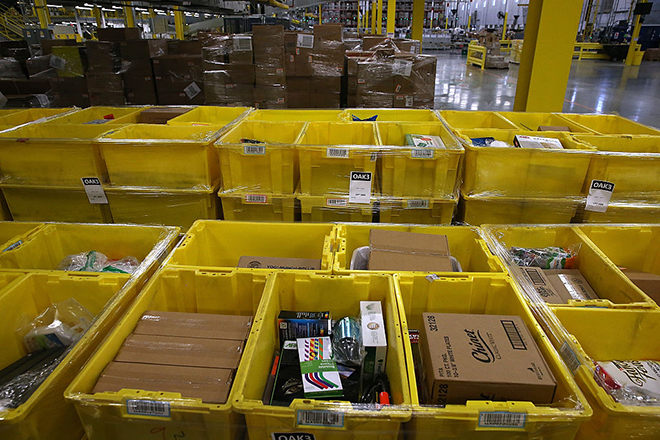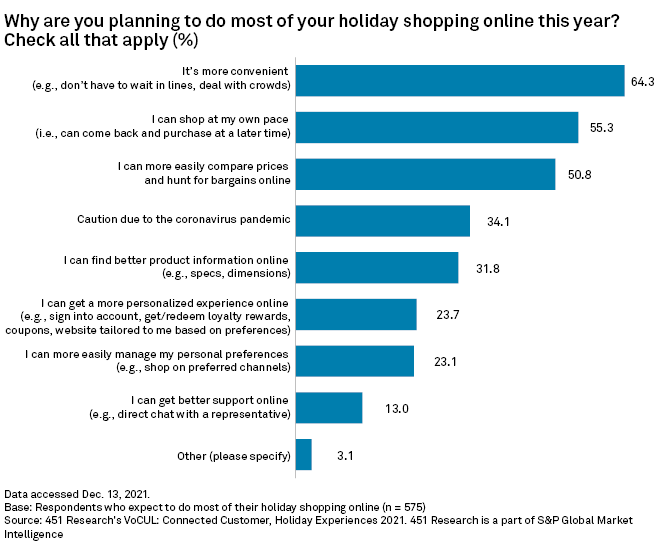S&P Global Offerings
Featured Topics
Featured Products
Events
S&P Global Offerings
Featured Topics
Featured Products
Events
S&P Global Offerings
Featured Topics
Featured Products
Events
Banking & Capital Markets
Economy & Finance
Energy Transition & Sustainability
Technology & Innovation
Podcasts & Newsletters
Banking & Capital Markets
Economy & Finance
Energy Transition & Sustainability
Technology & Innovation
Podcasts & Newsletters
S&P Global Offerings
Featured Topics
Featured Products
Events
16 Dec, 2021
 Merchandise sits in containers at an Amazon fulfillment center in Tracy, Calif.
Merchandise sits in containers at an Amazon fulfillment center in Tracy, Calif.
The e-commerce industry is expected to hold on to pandemic-elevated sales into 2022, with big retailers including Amazon.com Inc. and Walmart Inc set to benefit as consumers stick to new, hybrid shopping patterns.
U.S. e-commerce sales are on track to exceed $1 trillion for the first time next year, as sales growth plateaus but total purchases remain far above pre-pandemic levels, according to a recent forecast by eMarketer. E-commerce sales grew by 32.4% between 2019 and 2020, reflecting the abrupt shift to online shopping, working and learning during first waves of the pandemic. The growth rate fell to an estimated 16.1% between 2020 and 2021 and is expected to remain near that level for the next two years. Total sales will reach an estimated $1.065 trillion next year, according to eMarketer's forecast.
"There's been a shift in the way people consume and that is unlikely to go away in the near term," said Gregory Daco, chief U.S. economist with Oxford Economics. "We're still in an environment of COVID fear, COVID uncertainty, and that will continue to drive people's purchasing habits."
A 451 Research survey fielded in October found that while some shoppers reported changing their habits due to the pandemic, convenience outranked COVID-19 as a key factor driving a portion of holiday shopping online. About one-fifth of respondents to 451's Voice of the Connected User Landscape: Connected Customer, Holiday Experiences survey said most of their in-store shopping had shifted online as a result of COVID-19, and another one-third said some of their shopping had shifted.
Among those who planned to do most of their holiday shopping online, convenience was cited as the reason among 64.3% of respondents, followed by the ability to shop at their own pace (55.3%) and the ease of comparing prices and hunting for bargains online (50.8%).

For big e-commerce retailers that spent heavily to optimize delivery schedules amid labor shortages and supply chain challenges, that means online sales should begin to normalize at pandemic-heightened levels, leading to more favorable year-over-year comparisons, industry analysts said.
Amazon's pandemic-era investments in its delivery and infrastructure network should pay dividends next year, particularly as the company's long-awaited one-day delivery gets off the ground, said Tuna Amobi, media and entertainment analyst for CFRA. In addition to investing in infrastructure for its one-day delivery initiative, Amazon also doubled its container processing capacity and expanded its air cargo fleet to help it manage the fourth-quarter holiday season. As a result, it is much less reliant on third-party carriers for deliveries.
"They've take more control," Amobi said. "They've gotten fulfillment much closer to the consumer."
Amobi also noted that Amazon's Prime subscriber base shows no signs of slowing down as the e-commerce giant adds more perks to the subscription service, which now bundles premium shipping, exclusive deals and other content. Amazon surpassed 200 million Prime members this year, up from 150 million in 2020.
Both Walmart and Target Corp. have rolled out expanded delivery options to try and keep up.
|
|
Through its Walmart+ membership program launched in late 2020, the Arkansas-based retailer offers unlimited free delivery on more than 160,000 items including household goods and groceries. Meanwhile, Target last year expanded its Order Pickup and Drive Up services to include fresh and frozen grocery items, in addition to more than 250,000 items available for pickup in areas such as home and apparel.
Both retailers hope to take more e-commerce market share to complement their traditional brick-and-mortar businesses, noted Michael Baker, managing director with D.A. Davidson.
Arun Sundaram, senior equity research analyst with CFRA, said he expects Walmart to spend a total of $15 billion in capital expenditures in 2022, which would equate to about 2.6% of the company's sales, a portion of which is likely to go toward digital infrastructure. "They do have a lot of old technology that needs to be updated or fully replaced," Sundaram said.
"They can either invest themselves and build it out organically or buy a company that specializes in a certain area," the analyst said.
Meanwhile, Target, a much smaller rival, is expected to continue to lean into enhanced delivery services such as Shipt to improve its online experience. Target chose to buy its way into national same-day delivery service with its 2017 acquisition of Shipt, Sundaram said.
Before Shipt, "they were very weak on the delivery front," Sundaram said. "That acquisition has helped a lot."

